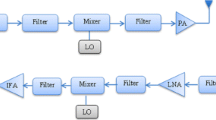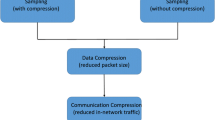Abstract
We present in this paper a new energy-efficient communication scheme called CNS (Compression with Null Symbol) that combines the power of data compression and communication through silent symbol. The concept of communication through silent symbol is borrowed from the energy efficient schemes proposed in Sinha (Proceedings of 6th IEEE consumer communications and networking conference (CCNC), Las Vegas, pp. 1–5, 2009), Ghosh et al. (Proceedings of 27th IEEE international performance computing and communications conference (IPCCC), USA, pp. 85–92, 2008), and Sinha and Sinha (Proceedings of international conference on distributed computing and internet technologies (ICDCIT), LNCS, pp. 139–144, 2008). We show that the average theoretical energy saving at the transmitter by CNS is 62.5%, assuming an ideal channel and for equal likelihood of all possible binary strings of a given length. Next, we propose a transceiver design that uses a hybrid modulation scheme utilizing FSK and ASK so as to keep the cost/complexity of the radio devices low. Considering an additive white gaussian noise (AWGN) channel and a non-coherent detection based receiver, CNS shows a saving in transmitter energy by 30% when compared to binary FSK, for equal likelihood of all possible binary strings of a given length. Simultaneously, there is a saving of 50% at the receiver for all types of data modulation due to halving of the transmitted data duration, compared to binary encoding. In contrast, RBNSiZeComm proposed in Sinha (Proceedings of 6th IEEE consumer communications and networking conference (CCNC), Las Vegas, pp. 1–5, 2009), TSS proposed in Ghosh et al. (Proceedings of 27th IEEE international performance computing and communications conference (IPCCC), USA, pp. 85–92, 2008) and RZE proposed in Sinha and Sinha (Proceedings of international conference on distributed computing and internet technologies (ICDCIT), LNCS, pp. 139–144, 2008) generate average transmitter energy savings of about 41, 20, and 35.2%, respectively. Also, at the receiver side, while RBNSiZeComm does not generate any saving, TSS and RZE produce about 36.9 and 12.5% savings on an average, respectively. Considering certain data types that may occur in the context of some wireless sensor networks (WSN) based applications (e.g., remote healthcare, agricultural WSNs, etc.), our simulation results demonstrate that for AWGN noisy channels, the transmitter side savings vary from about 33–50% on an average, while for RBNSiZeComm, this saving is about 33–61% on the same data set (Sinha in Proceedings of 6th IEEE consumer communications and networking conference (CCNC), Las Vegas, pp. 1–5, 2009). Thus, taking into account the low cost/complexity of the proposed transceiver, these results clearly establish that CNS can be a suitable candidate for communication in low power wireless sensor networks, such as in remote healthcare applications, body area networks, home automation, WSNs for agriculture and many others.








Similar content being viewed by others
References
Demirkol, I., Ersoy, C., & Alagoz, F. (2005). Mac protocols for wireless sensor networks, a survey. IEEE Communications Magazine.
Zijian, W., Bulut, E., & Szymanski, B. K. (2009). Energy efficient collision aware multipath routing for wireless sensor networks. In Proceedings of IEEE international conference on communications (pp. 1–5).
Sinha, K., Ghose, S., & Srimani, P. K. (2008). Fast deterministic broadcast and gossiping algorithms for mobile ad hoc networks. Journal of Parallel and Distributed Computing (JPDC), 68(7), 922–938.
Cagalj, M., Hubaux, J.-P., & Enz, C. C. (2005). Energy-efficient broadcasting in all-wireless networks. Wireless Networks, 11(1/2), 177–188.
Chen, Y. P., Liestman, A. L., & Liu, J. (2005). Energy-efficient data aggregation hierarchy for wireless sensor networks. In Proceedings of 2nd international conference on quality of service in heterogeneous wired/wireless networks (QShine ’05), Orlando, FL.
Vergados, D. J., Pantazis, N. A., & Vergados, D. D. (2008). Energy-efficient route selection strategies for wireless sensor networks. Mobile Networks and Applications, 13(3), 285–296.
Vergados, D. J., Pantazis, N. A., & Vergados, D. D. (2007). Enhanced route selection for energy efficiency in wireless sensor networks. In Proceedings of international conference on mobile multimedia communication.
Trigoni, N., Yao, Y., Demers, A., Gehrke, J., & Rajaraman, R. (2004). WaveScheduling: Energy-efficient data dissemination for sensor networks. In Proceedings of internatioanal workshop on data management for sensor networks (Vol. 72, pp. 48–57).
Kandris, D., Tsioumas, P., Tzes, A., Nikolakopoulos, G., & Vergados, D. D. (2009). Power conservation through energy efficient routing in wireless sensor networks. Sensors, 9(9), 7320–7342.
Vidhyapriya, R., & Vanathi, P. T. (2007). Energy aware routing for wireless sensor networks. In Proceedings of international conference on signal processing, communications and networking (pp. 545–550).
Hey, L. A. (2008). Power aware smart routing in wireless sensor networks. Next Generation Internet Networks, 195–202.
Heinzelman, W. B., Chandrakasan, A., & Balakrishnan, H. (2000). Energy efficient communication protocol for wireless microsensor networks. In Proceedings of international conference on system science.
Enz, C., El-Hoiydi, A., Decotignie, J.-D., & Pereis, V. (2004). WiseNET: An ultralow-power wireless sensor network solution. IEEE Computer, 37(8), 62–70.
Yang, X., & Vaidya, N. H. (2004). A wakeup scheme for sensor networks: achieving balance between energy saving and end-to-end delay. Proceedings of IEEE real-time and embedded tech. and applications symposium (RTAS’04).
Wu, Y., Li, X.-Y., Liu, Y., & Lou, W. (2010). Energy-efficient wake-up scheduling for data collection and aggregation. IEEE Transactions on parallel and distributed systems, 21(2).
Mahtre, V., & Rosenberg, C. (2005) Energy and cost optimizations in wireless sensor networks: a survey. In A. Girard, B. Sanso, & F. Vazquez-Abad (Eds.), Performance evaluation and planning methods for the next generation internet (25th anniversary volumes of GERAD). Kluwer.
Akyilidiz, I. F., Su, W., Sankarasubramaniam, Y., & Cayirci, E. (2002). Wireless sensor networks: A survey. Computer Networks, 38(4), 393–422, March 2002.
Al-Karaki, J. N., & Kamal, A. E. (2004, Dec). Routing techniques in wireless sensor networks: a survey.IEEE Wireless Communications, 11(6).
Pantazis, N., & Vergados, D. D. (2007). A survey on power control issues in wireless sensor networks. IEEE Communications Surveys and Tutorials, 9(4), 86–107.
Pantazis, N. A., Vergados, D. J., Vergados, D. D., & Douligeris, C. (2009). Energy efficiency in wireless sensor networks using sleep mode TDMA scheduling. Ad-hoc Networks Journal, Elsevier, 7(2), 322–349.
Ma, J., Lou, W., Wu, Y., Li, X.-Y., & Chen, G. (2009). Energy efficient TDMA sleep scheduling in wireless sensor networks. In Proceedings of IEEE INFOCOM (pp. 630–638).
Gobriel, S., Mosse, D., & Cleric, R. (2009). TDMA-ASAP: Sensor network TDMA scheduling with adaptive slot-stealing and parallelism. In Proceedings of international conference on distributed computing systems (pp. 458–465).
Zhu, J., Qiao, C., & Wang, X. (2006, Nov). On accurate energy consumption models for wireless ad hoc networks. IEEE Trans. on Wireless Communications, 5(11).
Wang, L., & Manner, J. (2009). Evaluation of data compression for energy-aware communication in mobile networks. In Proceedings of international conference on cyber-enabled distributed computing and knowledge discovery (pp. 69–76).
Zhu, Y., & Sivakumar, R. (2005). Challenges: communication through silence in wireless sensor networks. In Proceedings of international conference on mobile computing and networking (MobiCom) (pp. 140–147).
Zhu, Y. (2007, Aug). Energy-efficient communication strategies for wireless sensor networks (pp. 73–133). Ph.D. Thesis, Georgia Institute of Technology.
Chen, Y. P., Wang, D.,& Zhang, J. (2006). Variable-base tacit communication: a new energy efficient communication scheme for sensor networks. In Proceedings of 1st international conference on integrated internet ad hoc and sensor networks (intersense), Nice, France.
Proakis, J. G.(2000). Digital communication. New York: McGraw-Hill.
Polastre, J., Szewczyk, R., & Culler, D. (2005). Telos: Enabling ultra-low power wireless research. In Proceedings of international symposium on information processing in sensor networks (pp. 364–369).
Ye, W., Heidemann, J., & Estrin, D. (2002). An energy-efficient MAC protocol for wireless sensor networks. In Proceedings of IEEE Infocom (pp. 1567–1576).
Sinha, K. (2009, Jan). An energy efficient communication scheme for applications based on low power wireless networks. In Proceedings of 6th IEEE consumer communications and networking conference (CCNC) (pp. 1–5), Las Vegas, USA.
Ghosh, R. N., Sinha, K., Sinha, B. P., & Datta, D. (2008, Dec). TSS: An energy efficient communication scheme for low power wireless networks. In Proceedings of 27th IEEE international performance computing and communications conference (IPCCC), USA (pp. 85–92).
Sinha, K., & Sinha, B. P. (2008, Dec). An energy efficient communication scheme for distributed computing applications in wireless sensor networks. In Proceedings of international conference on distributed computing and internet technologies (ICDCIT) (LNCS, pp. 139–144).
NTP: The Network Time Protocol, http://www.ntp.org.
Mirabella, O., Brischetto, M., Raucea, A., & Sindoni, P. (2008). Dynamic continuous clock synchronization for IEEE 802.15.4 based sensor networks. In Proceedings of IEEE annual conference on industrial electronics (pp. 2438–2444).
Song, P., Shan, X., Li, K., & Qi, G. (2009). Highly precise time synchronization protocol for zigBee networks. In Proceedings of IEEE/ASME international conference on advanced intelligent mechatronics (pp. 1254–1258).
Sinha, K., & Sinha, B. P. (2009). On the distribution of runs of ones in binary strings. Computers and Mathematics with Applications, Elsevier, 58, 1816–1829.
Marinkovic, S., Spagnol, C., & Popovici, E. (2009). Energy-efficient TDMA-based MAC protocol for wireless body area networks. In Proceedings of international conference on sensor technologies and applications (pp. 604–609).
Omeni, O., Wong, A. C. W., Burdett, A. J., & Toumazou, C. (2008, Dec). Energy efficient medium access protocol for wireless medical body area sensor networks. In IEEE Transactions on Biomedical Circuits and Systems, 2(4).
Jea, D., Liu, J., Schmid, T., & Srivastava, M. (2008, June). Hassle free fitness monitoring. In 2nd International workshop on systems and networking support for healthcare and assisted living environments (HealthNet).
Jea, D., et. al. (2008, Aug). Diagnostic quality driven physiological data collection for personal heathcare. In Proceedings of 30th annual international conference of the IEEE on engineering in medicine and biology society (EMBS).
Laguna, P., Mark, R. G., Goldberger, A., & Moody, G. B. (1997). A database for evaluation of algorithms for measurement of QT and other waveform intervals in the ECG. Computers in Cardiology, 24, 673–676.
Systemic Pathology Laboratory, http://www.tigerpath.com/unit_08.htm, 2008.
Burrell, J., Brooke, T., & Beckwith, R. (2004). Vineyard computing: sensor networks in agricultural production. IEEE Pervasive Computing, 3(1), 38–45, Jan-Mar, 2004.
Mestre, P., Peres, E., & Serôdio, C. (2005). Agricultural monitoring and control system using low-cost wireless sensors networks. In Proceedings of 5th EFITA/WCCA (pp. 837–844).
Morais, R., Valente, A.& Serôdio, C. (2005). A wireless sensor network for smart irrigation and environmental monitoring: A position article. In 5th European federation for information technology in agriculture, food and environement and 3rd world congress on computers in agriculture and natural resources (EFITA/WCCA) (pp. 845–850).
Beckwith, R., Teibel, D.,& Bowen, P. (2004). Report from the field: results from an agricultural wireless sensor network. In Proceedings of IEEE international conference on local computing networks (LCN).
Li, Y., Ye, W., & Heidemann J. (2005). Energy and latency control in low duty cycle MAC protocols. In Proceedings of IEEE wireless communications and networking conference (pp. PHY 30–34).
Author information
Authors and Affiliations
Corresponding author
Rights and permissions
About this article
Cite this article
Sinha, K., Sinha, B.P. & Datta, D. CNS: a new energy efficient transmission scheme for wireless sensor networks. Wireless Netw 16, 2087–2104 (2010). https://doi.org/10.1007/s11276-010-0245-3
Published:
Issue Date:
DOI: https://doi.org/10.1007/s11276-010-0245-3




